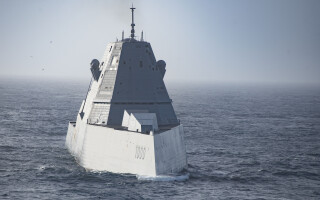Time-Sensitive Networking (TSN) enables deterministic military networks
Sponsored StoryJune 13, 2024

Aerospace & defense (A&D) program managers and system integrators looking for a higher level of interconnection of subsystems and sensors are leveraging Time-Sensitive Networking (TSN), a more deterministic version of Ethernet. Defense applications for the technology include avionics, sensor systems, communications, uncrewed systems, and more.
As defense networks become more interconnected mission-critical data must be processed in real time without the bottlenecks caused by networks that rely on technology such as traditional Ethernet. More deterministic systems are needed that enable real-time processing of data from multiple sensors and systems on different networks to enable better data fusion in military networks where reaction from sensor data is vital to mission success.
Traditional Ethernet (IEEE 802.3 and 802.1Q) has no concept of time regarding data delivery, and thus it is not possible to ensure all real-time data arrives at its destination on time – especially as data loads increase. Deterministic system behavior thus cannot be achieved.
TSN, a set of standards specified by IEEE 802, addresses this problem, guaranteeing minimal network latency and jitter, and providing for bounded end-to-end delay and guaranteed message delivery time. TSN also allows for the transmission of time-sensitive and non-time-sensitive data on the same network. Its features enable deterministic networking over general-purpose Ethernet. However, definition of the relevant specifications is ongoing, with some defined and included in the main IEEE 802.1Q-2022 specification and some like cut-through (P802.1DU) in progress – all tackling different issues and functionality.
For aerospace applications, the IEEE P802.1DP - TSN for Aerospace Onboard Ethernet Communications specifies profiles of IEEE 802.1 TSN and IEEE 802.1 Security standards for aerospace onboard bridged Ethernet networks.
Reduced complexity
While standards development progresses, A&D programs are already listing TSN in system requirements to take advantage of its reduced complexity. Modular systems design, such as within a vehicle or aircraft, makes development, testing, deployment, and upgrades less complex and hence more cost-effective. Ethernet is commonly used for inter-module, intra-module, and inter-component communication. Such systems typically suffered from the limitation of non-deterministic real-time data delivery. TSN addresses this issue – enabling systems engineers to achieve accurate and repeatable timing for highly reliable real-time communication over standardized Ethernet as opposed to custom communications buses/solutions.
Other benefits of TSN include:
- Quality of service
- Scalability
- Data access
- Improved monitoring/fault detection
- Better cyber resiliency
- Futureproofing
- Convergence of IT and OT networks
- Interoperability and vendor neutrality
Interoperability and vendor neutrality are especially critical in today’s defense environment, in which the U.S. Department of Defense (DoD) has mandated a modular open systems approach (MOSA) for all new programs and upgrades. TSN standards are designed to be open and interoperable, allowing different vendors' devices to work seamlessly together, building an open and robust ecosystem.
Despite the enthusiasm of many end users for TSN, there are still those who are reticent to adopt the TSN standard, as portions of it are still not fully defined, matured, and ratified, especially the industry profiles.
However, we say there is a back-to-basics approach that implementers can use in adopting the standard today with an eye to future-proofing their systems for tomorrow, which we detail in the white paper titled “Hitting the Moving Target with Time-Sensitive Networking.”
The goal of more deterministic networking is not unique to aerospace and defense users as hardware, operating systems, and applications implementers across industries including A&D and automotive share a common perspective on the issue.
We are starting to see more flow-down requirements in both A&D and automotive that specify some or all the TSN standard for new designs. With the growth of more autonomous capabilities, advanced sensors, data collection from edge devices, IoT networks, and more, TSN is becoming a baseline requirement. There are clear benefits to having a deterministic network approach, which we cover in the paper.
The success of TSN depends on interoperability and performance. In this document, the undersigned organizations have come together to affirm that the standards referenced herein are immutable components of TSN and form the foundation of our products and offerings in our respective markets.
To date, some 20 standards have been completed and another 10 are in draft status. In section 5 of the white paper, we share our recommendations for how and specifically which portions of the standard should be (safely) adopted.
- The benefits of TSN
- The ongoing work on TSN
- About industry verticals and TSN profiles
- How this “moving target” can be addressed by a ”back-to-basics” approach.
- About which organizations have a baseline TSN offering, involving established aspects of IEEE 802.1, to create successful mission-critical systems today and to be future-proof tomorrow.
Vendors and implementers will continue to collaborate to refine the set of standards that comprise TSN. Results from real-world implementations may influence the standards’ refinement, but the standards discussed in the paper form the foundation for confident product development.
Companies contributing to the white paper are: Aptiv Corp., Intel Corp., Lockheed Martin Corp., Parry Labs, TTTechAuto, and Wind River Systems, Inc.






